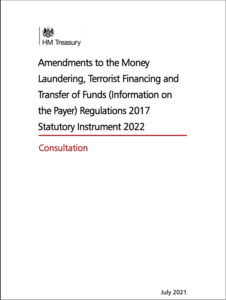In July 2021, HM Treasury published two consultations that invite input from art market stakeholders.
The following areas are covered:
- ‘Digital art’ being included in the definition of ‘work of art’ in context of the Money Laundering Regulations (meaning that digital art transactions for 10K+ Euros would also trigger the need to conduct AML checks). This incorporates the meaning of ‘digital art’.
- ‘Artists’ being caught under scope of anti-money laundering legislation… or not.
- Who is an ‘artist’, anyway – the person who made a piece or to whom it is attributed? And the individual vs the artist business?
- How cryptoassets are being regulated for AML… which could incorporate NFTs.
- Inclusion of ‘antiquities’ as a sector regulated under the Money Laundering Regulations.
If the above points pique your interest, keep reading and get involved by responding to one or both of the consultations explained and linked below.
Deadline for responses: 14th October 2021.
Email responses can be sent to [email protected] .
The above consultation focuses on amendments to the existing Money Laundering Regulations, the results of which are set to be passed as a Statutory Instrument in Parliament (Spring 2022).
Key points for the art market to address:
Chapter 2: Changes in scope to reflect latest risk assessments:
This focuses on the possible inclusion of artists (incorporating artist estates) and considers if digital art will be brought into scope.
> Clause 2.30 suggests a definition of ‘artist’.
–> Food for thought: Considering the intention of AML legislation in context of potential vulnerabilities of artist businesses being targeted by criminals, might artists who are selling direct (not via a regulated dealer / gallery / platform) be caught in scope of the Money Laundering Regulations?
–> Where to respond: Box 2.C, question no. 11 (see the wording for the proposed new definition of an AMP in Annex D, 14 on p. 50 of the consultation).
> Clause 2.33 gives a definition of digital art.
–> Food for thought: Might digital art not be how it’s made, but presented (for example, digital art can be printed on canvas and a painting can be presented as a video). That said, this does not include NFTs (see Chapter 6 below).
–> Where to respond: Box 2.C, question no. 12.
Chapter 6: Transfers of cryptoassets
This broadly considers how cryptoassets are being handled.
> Clause 6.7 proposes that the whole of the cryptoasset sector is handled in one place, which could include NFTs (althogh not specifically named in the consultation). See the definition of ‘cryptoasset’ in the footnote on page 29.
–> Food for thought: This could include NFTs.
–> Where to respond: Box 6.A, question no. 56 (and optionally 58 for timescale).
> Clause 6.12 notes what information might be required depending on the value of the transaction (converted from a cryptocurrency into GBP when applicable).
–> Where to respond: Box 6.B, question no. 59.
> Clause 6.24 suggests that the de minimis amount to trigger additional information to accompany the transfer be set at 1,000 GBP. This is obviously significantly lower than the 10K EUR threshold set for transactions involving ‘works of art’.
–> Where to respond: Box 6.C, question no. 60 (plus optionally 61 re: linked transactions).
CLICK HERE to open and download the consultation: Amendments to the MLRs 2017 as a Statutory Instrument 2022.
The above consultation reviews the regulatory and supervisory regime. A highlight for the art market is that it will potentially bring antiquities into scope. The results with proposed reforms are set to be published in a report in summer 2022.
Key points for the art market to address:
Chapter 2: Systemic review
> Clause 2.17 specifies antiquities as a potential new sector.
–> Food for thought: What might be the definition of ‘antiquities’? Much like defining an artist and work of art as in the first consultation above, this is a key point for consideration and suggestion by the industry.
–> Where to respond: (iv) Extent of the regulated sector, question no. 12.
CLICK HERE to open and download the consultation: Supervisory regime call for evidence, with a resulting report to be published in Summer 2022.

